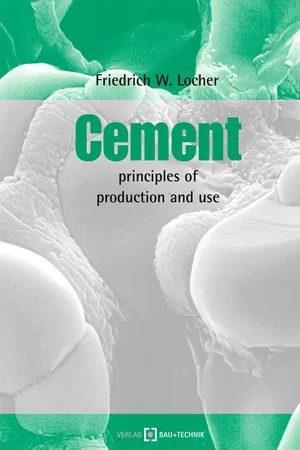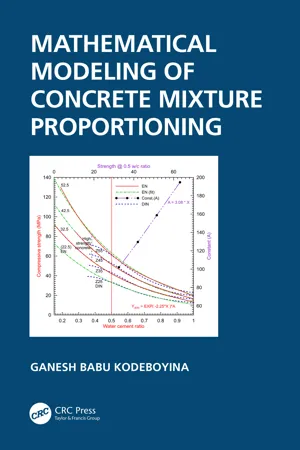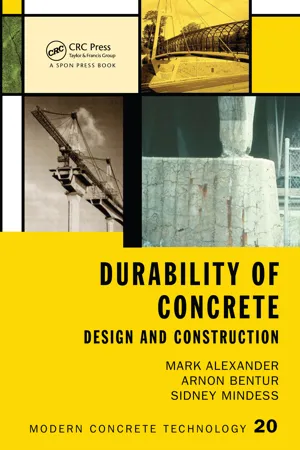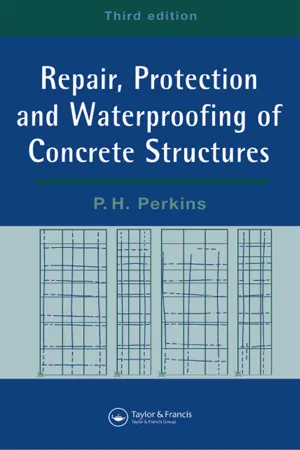Cement and Concrete
Cement is a binding agent used to make concrete, which is a composite material consisting of cement, water, and aggregates such as sand and gravel. Concrete is a versatile construction material known for its strength, durability, and ability to be molded into various shapes. It is widely used in building and infrastructure projects.
8 Key excerpts on "Cement and Concrete"
- eBook - ePub
Brickwork and Bricklaying
A DIY Guide
- Jon Collinson(Author)
- 2013(Publication Date)
- Crowood(Publisher)
...CHAPTER 2 Concrete Concrete is a mixture of cement (usually Ordinary Portland cement), acting as a binder, fine aggregates such as sharp sand, and coarse aggregates such as gravel or crushed stone. Alternatively, fine and coarse aggregates may come pre-mixed as all-in ballast. Water is added to form a paste with the cement, which covers the surface area of every stone and aggregate particle in the mix, binding them together to form a solid mass when the concrete hardens. The aggregates are not physically altered in any way, but are firmly set into the hardened, rock-like cement paste. Concrete has numerous applications, among them the foundations of buildings, oversite concrete under suspended timber ground floors, solid floor slabs, driveways, paths, benching in man-holes, and many others. In some cases a chemical plasticizer is mixed with the water in order to make the concrete easier to work and to protect it from frost while it sets. CEMENT Cement is generally regarded as the most important binding material used in the construction process and is used for the manufacture of mortar and concrete. The use of cement is so common that it is the second most consumed substance in the world after water! The most commonly used is Ordinary Portland cement (OPC), so called because, in its solid state, its grey colour is much like that of natural Portland stone. The fact that Portland cements form a solid when mixed with water means they are often referred to as ‘ hydraulic cements’. Hydration The reaction between the cement and water is an exothermic (meaning ‘giving off heat’) chemical reaction known as ‘hydration’, which results in the setting of the cement paste. Concrete, and mortars for that matter, set as a result of the completion of the hydration process and not simply by drying out. Fig. 1 Ordinary Portland cement. Fig...
- eBook - ePub
- P.K. Jayasree, K Balan, V Rani(Authors)
- 2021(Publication Date)
- CRC Press(Publisher)
...The paste, comprising cement and water, binds the aggregates (usually sand and gravel or crushed stone) into a rocklike mass as the paste hardens. Portland cement is made from a combination of a calcareous material (usually limestone) and of silica and alumina found as clay or shale. In lesser amounts, it can also contain iron oxide and magnesia. Aggregates, which comprise 75% of concrete by volume, improve the formation and flow of cement paste and enhance the structural performance of concrete. Aggregates can also be classified according to the type of rock they consist of: basalt, flint, and granite, among others. A wide range of chemicals called admixtures are added to cement to act as plasticizers, superplasticizers, accelerators, set retarders, dispersants, and water-reducing agents. Accelerators which are used to reduce the setting time, include calcium chloride or aluminum sulfate and other acidic materials. Plasticizing or superplasticizing agents increase the fluidity of the fresh cement mix with the same w/c ratio, thereby improving the workability of the mix as well as its ease of placement. Examples of plasticizers are polycarboxylic acid materials while those of superplasticizers are sulfanated melamine formaldehyde or sulfanated naphthalene formaldehyde condensates. Set retarders are used to delay the setting of concrete. These include soluble zinc salts, soluble borates, and carbohydrate-based materials. Gas forming admixtures, powdered zinc, or aluminum in combination with calcium hydroxide or hydrogen peroxide, are used to form aerated concrete by generating hydrogen or oxygen bubbles that become entrapped in the cement mix. 9.6.1 Manufacturing Process First, the cement (usually Portland cement) is measured. Next, the other ingredients—aggregates (such as sand or gravel), admixtures (chemical additives), any necessary fibers—are measured and dry-mixed together...
- eBook - ePub
- S.K. Duggal(Author)
- 2017(Publication Date)
- Routledge(Publisher)
...This cement was the prototype of the modem Portland cement. From then onwards, a gradual improvement in the properties and qualities of cement has been made possible by researchers in U.S.A., U.K., France and Germany. Cements in a general sense are adhesive and cohesive materials which are capable of bonding together particles of solid matter into a compact durable mass. For civil engineering works, they are restricted to calcareous cements containing compounds of lime as their chief constituent, its primary function being to bind the fine (sand) and coarse (grits) aggregate particles together. Cements used in construction industry may be classified as hydraulic and non-hydraulic. The latter does not set and harden in water such as non-hydraulic lime or which are unstable in water, e g. Plaster of Paris. The hydraulic cements set and harden in water and give a product which is stable. Portland cement is one such. Cement can be manufactured either from natural cement stones or artificially by using calcareous and argillaceous materials. The examples of natural cements are Roman cement, Puzzolana cement and Medina cement and those of artificial cement are Portland cement and special cements. Today cement finds extensive use in all types of construction works; in structures where high strength is required e.g. bridge piers, light houses, lofty towers, and large structures such as bridges, silos, chimneys. And also in structures exposed to the action of water, e.g. reservoirs, dams, dock yards etc. Cement mortar, concrete, reinforced brick work, artificial stones, plastering, pointing and partition walls are routinely used in buildings. 5.2 Portland Cement It is a cementing material resembling a natural stone quarried from Portland in U.K. Portland cement may be defined as a product obtained by finely pulverizing clinker produced by calcining to incipient fusion, an intimate and properly proportioned mixture of argillaceous and calcareous materials...
- eBook - ePub
- Greg McNally(Author)
- 2017(Publication Date)
- CRC Press(Publisher)
...CHAPTER 8 Concrete materials and mix design Concrete is an artificial rock made by blending coarse and fine aggregates, cement powder, water and—increasingly—chemical additives. In the wet state it can be poured into complex shapes within formwork, where the cement and water react together by hydration. This forms a gel, referred to here as the ‘cement paste’, which sets (stiffens) within a few hours and then hardens at a diminishing rate over the following days, weeks and even years. About 30% of the ultimate strength is typically achieved within 24 hours, about 50% within one week, and upwards of 80% after four weeks (Figure 8.1). Water is required both for the hydration process and to make the wet concrete workable so that it can be pumped, poured and compacted. Concrete mixes of low workability, usually because of insufficient fine aggregate or water, are said to be ‘harsh’. However, excess water in the mix greatly reduces its hardened strength and increases its shrinkage on drying. Hence the water/cement ratio (WCR) by weight is an important factor in mix design. A ‘low’ WCR is in the range 0.3–0.4, but mixtures of this consistency are very stiff and require chemical additives to make them workable. On the other hand, compressive strengths at a WCR of 0.7 may be only half those at 0.4, as shown in Figure 8.1. Many of the properties of hardened concrete are similar to those of moderately strong sandstone, though concrete is much more homogeneous, stiffer and more brittle, particularly at low strengths. The modulus ratio (E / UCS) of concrete is considerably higher, 500–1300 (compared with about 200 for most sandstones). Normal concrete has compressive strengths in the range 7–40 MPa, while ‘high’ strengths are 40–100 MPa. Like rock, concrete is strong in compression and weak in tension, but unlike rock it can have its flexural (bending tensile) strength increased by reinforcing bars or even fibreglass strands...
- eBook - ePub
Cement
principles of production and use
- Friedrich W. Locher(Author)
- 2013(Publication Date)
- Bau + Technik(Publisher)
...2 History of cement 2.1 The material basis of hydraulic binders The name “cement” goes back to the Romans who used the term “opus caementitium” to describe masonry which resembled concrete and was made from crushed rock with burnt lime as the binder. The volcanic ash and pulverized brick additives which were added to the burnt lime to obtain a hydraulic binder were later referred to as cementum, cimentum, cäment and cement [ Q 1, h 1, d 2, l 2 ]. The significance of the clay content for the hydraulic properties of the hydraulic lime produced from a natural mixture of limestone and clay was discovered by the Englishman John Smeaton (1724-1792) when he was preparing to build the Eddystone lighthouse near Plymouth and was looking for a binder for water-resistant mortar. In 1796 his compatriot James Parker used the name “Roman cement” for the Roman lime which he burnt from the marl nodules in London septarian clay. The Frenchman Louis-Joseph Vicat (1786-1861) and the German Johann Friedrich John (1782-1847) discovered independently of one another that mixtures of limestone and 25 to 30 % by mass of clay were the most suitable for producing hydraulic lime. The binder which Joseph Aspdin (1778-1855) produced by burning an artificial mixture of limestone and clay, and for which he obtained a patent in 1824 under the name of “Portland cement”, also at first corresponded in composition and properties to a Roman lime, as it had not yet been burnt to the sintering point. The artificial rock produced from it resembled Portland stone, an oölitic limestone which is quarried on the Portland peninsula in the county of Dorset on the Channel coast. When William Aspdin, the son of Joseph Aspdin, started to produce Portland cement in 1843 in a newly established works at Rotherhithe near London it became apparent, especially during the construction of the Houses of Parliament London, that this was far superior to “Roman cement”...
- Ganesh Babu Kodeboyina(Author)
- 2020(Publication Date)
- CRC Press(Publisher)
...Also, though the primary constituent, cement, is factory produced, the fact that it can be used by local artisans even with a very limited skill set makes it the choicest material for most construction. The complexity of the concretes required for the more intricate and demanding requirements, however, need an in-depth understanding of their production, transport, placing, curing and maintenance. Essentially, concrete is a conglomerate in its true sense, and in attempting to devise methodologies of arriving at the best stone-like mass, one could look at the examples of the different natural processes that led to the formation of the conglomerate itself. In a conglomerate, one could see that the different constituents have to be appropriately packed to ensure that the final fused mass due to the chemical, thermal and pressure effects over time result in the different possible strengths of the composite stone mass, varying from very high strength sand stones to the highly porous and fragile laterites that exist. Another aspect that may be of relevance in this context is to note that while the hardest of sand stones are in general fused mass of highly siliceous agglomerates formed under temperature and pressure, laterites are weak and mostly fragile masses of iron and aluminum oxides. This in a way shows the contribution of the basic constituents and the effectiveness of the binder in the final product, which probably is a good guiding principal for ensuring the appropriate characteristics in the case of concrete as well. In effect, the constituents of concrete have to be appropriately chosen and compacted to ensure a defect free system which, after the effects of hydration, could have the highest strength possible. Incidentally, it is clear from the above that neither just an effective packing nor alternatively an efficient bonding mechanism alone will ensure the highest strength...
- eBook - ePub
Durability of Concrete
Design and Construction
- Mark Alexander, Arnon Bentur, Sidney Mindess(Authors)
- 2017(Publication Date)
- CRC Press(Publisher)
...Chapter 3 Materials for concretes in relation to durability 3.1 Introduction Prior to the early 1930s, concrete was a relatively simple, straightforward material, consisting only of “pure” Portland cement, aggregate, and water. These were combined in varying proportions to produce concretes with a range of compressive strengths and workabilities. In North America, it was only then that the first concrete additives began to come into general use: air-entraining, set-controlling, and water-reducing admixtures, and fly ash as a cement replacement. In Europe, ground-granulated blast-furnace slag (GGBFS) had been used since the beginning of the twentieth century, but the chemical admixtures were still not available until the 1930s. More recently, the numbers and types of materials being added to Portland Cement and Concrete have been growing at an accelerating pace, driven by a combination of economic considerations and a desire to make the Cement and Concrete industries more sustainable. Of course, both durable and non-durable concretes are made using much the same materials. The object is to ensure that the right materials are chosen for any particular project, taking into consideration both the exposure conditions and any special requirements for the concrete. In what follows, the materials found in modern concretes will be examined primarily in terms of their impact on the durability of concrete. This chapter deals only with the concrete-making materials themselves; the corrosion of steel reinforcement is dealt with in Chapters 4 and 8, and other durability issues are described in greater detail elsewhere in this book. 3.2 Portland cements and other binders Of all of the materials used to make concrete, it is the Portland cement-based binder that is the most unstable part of the system, and is responsible for most of the durability problems that may beset concrete. It may be subject to both chemical and physical attack, as shown in Table 3.1...
- P. Perkins(Author)
- 1997(Publication Date)
- CRC Press(Publisher)
...2 Basic characteristics of concrete and mortar and their constituent and associated materials 2.1 INTRODUCTION The characteristics of concrete and mortar depend largely on the characteristics of the materials used in their manufacture; the associated materials are needed to enable the concrete and mortar to be used for specific purposes. Constituent materials The constituent materials are: Portland cements—BS 12 etc and ENV 197–1; high alumina cement (HAC)—also known as calcium aluminate cement; corrosion-resistant cements; aggregates from natural sources for concrete and mortar; admixtures; water. Associated materials The main associated materials are: steel reinforcement; non-ferrous metals; joint fillers and sealants; polymers and reactive resins. The information given in this chapter is intended to be of a general nature and users of the materials listed should always refer to the latest edition of the relevant National Standard. CONSTITUENT MATERIALS 2.2 PORTLAND CEMENTS (European Standard ENV 197–1) Portland cement consists mainly of compounds of calcium silicate and calcium aluminate, the calcium silicates are predominate being between 55% and 85%. There is also tricalcium aluminate, 7% to 12% and ferrites 6% to 10%. It is made by burning at high temperature a mixture of chalk and clay in a rotary kiln. The clinker is ground, and gypsum is added to control the set. BS 12 limits the amount of sulphur (expressed as SO 3) to 3.5%. The fact that Portland cement contains sulphate is important when investigating the possibility of sulphate attack on the concrete or mortar, which is discussed in chapter 3...







